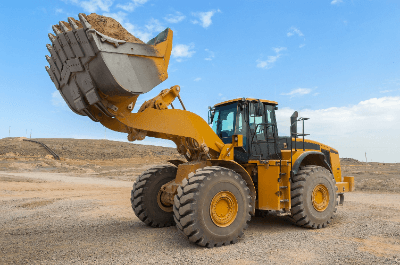What Is a Wheel Loader?

A wheel loader is a construction machine equipped with a bucket at the front, commonly used to load materials like soil and soft earth onto transport vehicles such as dump trucks.
With a large bucket, wheel loaders efficiently perform loading and leveling tasks. Equipped with tires, they can also self-propel for short-distance transport. Classified as a vehicle-type construction machine, it is also referred to as a tire shovel or tire dozer.
Wheel loaders come with a variety of attachments. By changing attachments according to the purpose, they can perform various tasks. Known for their maneuverability relative to their size, wheel loaders are among the most widely used construction machines on many job sites.
Uses of Wheel Loader
Wheel loaders have a wide range of applications due to their ability to change attachments. In addition to the construction industry, they are extensively used in snow removal, agriculture, forestry, and various other scenarios.
1. Construction Sites
On construction sites, wheel loaders are commonly used for loading materials like soil onto dump trucks. The large bucket enables efficient loading operations, allowing for more effective transport tasks compared to hydraulic shovels. Moreover, as wheel loaders have tire-driven mobility, they can self-propel for short-distance transport.
2. Snow Removal
In regions with snowfall, wheel loaders are widely employed for snow removal. By attaching an accessory called a snowplow, adjustments can be made to the angle and direction of snow discharge.
For driveways and large parking lots, wheel loaders with bucket attachments are more efficient than those without. During snow removal from parking lots, wheel loaders with bucket attachments load snow onto dump trucks for transport. Tire chains are essential when performing snow removal operations.
3. Agriculture
Wheel loaders are used in agriculture for tasks such as transporting and loading large quantities of materials like feed, compost, and soil. There are numerous agricultural attachments, including those suitable for gathering hay, grabbing and transporting rolled hay, and stacking. Wheel Loaders play a crucial role in agricultural operations.
4. Forestry
Equipped with fork attachments, wheel loaders are used for tasks like transporting timber and loading onto trucks. For tasks such as loading wood chips, which serve as biomass fuel or raw material for paper, larger buckets are typically attached for efficient operations.
5. Disaster Response
During disasters, the ground self-defense force utilizes wheel loaders for tasks like transporting soil, excavation, and leveling. In the ground self-defense force, they are referred to as bucket loaders.
6. Other Uses
Wheel loaders are also used in quarries, factories, and various other settings.
Features of Wheel Loader
Advantages
Wheel loaders have several advantages, including high mobility, ease of handling, and versatility across various scenarios.
1. High Mobility
Equipped with tires, wheel loaders boast exceptional mobility compared to other construction machines. They can smoothly perform transport tasks and easily move within job sites and on public roads.
2. Maneuverability
Wheel loaders have a pivot point slightly forward from the machine’s center, allowing the body to fold at that point. This folding mechanism provides excellent maneuverability, making them suitable for work in tight spaces or narrow roads. The folding design ensures that the front and rear wheels follow the same track, making it easy to drive.
3. Variety of Attachments
One notable feature of wheel loaders is the availability of numerous attachments. The wide range of attachments enables their use across various industries, making them one of the most versatile construction machines.
Disadvantages
While wheel loaders are highly versatile and widely used across various applications, they also have some disadvantages.
1. Limited Visibility
Wheel loaders suffer from poor visibility, especially to the rear. Although backup monitors are employed, blind spots are still a concern, requiring careful attention.
2. Tipping Hazard
When operating a wheel loader, caution is necessary to avoid tipping accidents. In soft ground conditions or during snow removal operations, the machine may tilt if the tires become buried, increasing the risk of tipping. Pre-operation checks of the ground surface safety are essential.
Types of Wheel Loaders
Wheel loaders are classified based on bucket capacity, and they come in various sizes. The size of the bucket affects the overall size of the machine, with bucket capacities ranging from 0.4 cubic meters to over 20 cubic meters.
The lineup caters to various needs, considering factors such as the size of the construction site and the scale of the project.
How to choose Wheel Loader
Selecting a wheel loader depends on the nature of the work and the location. With a diverse range of bucket capacities and sizes available, users can make choices that suit the type of work and the work environment.
For indoor operations, choosing a size that can maneuver in tight spaces is crucial for efficient operation.
Other information on Wheel Loaders
Qualifications and Licenses for Wheel Loader Operation
To operate a wheel loader, qualification and license are required.
1. Small Vehicle-Type Construction Machinery
For operating wheel loaders with a body mass of less than 3 tons, individuals must complete the “Special Education for Driving Operations of Small Vehicle-Type Construction Machinery.”
2. Vehicle-Type Construction Machinery
Operating wheel loaders with a body mass of 3 tons or more requires completion of the “Construction Machinery Driving Skills Training Course.”
3. Large Special License
Acquiring a large special license allows operation on public roads. The classification for large special vehicles includes those with a length of up to 12.0 meters, a width of up to 2.5 meters, and a height of up to 3.8 meters.